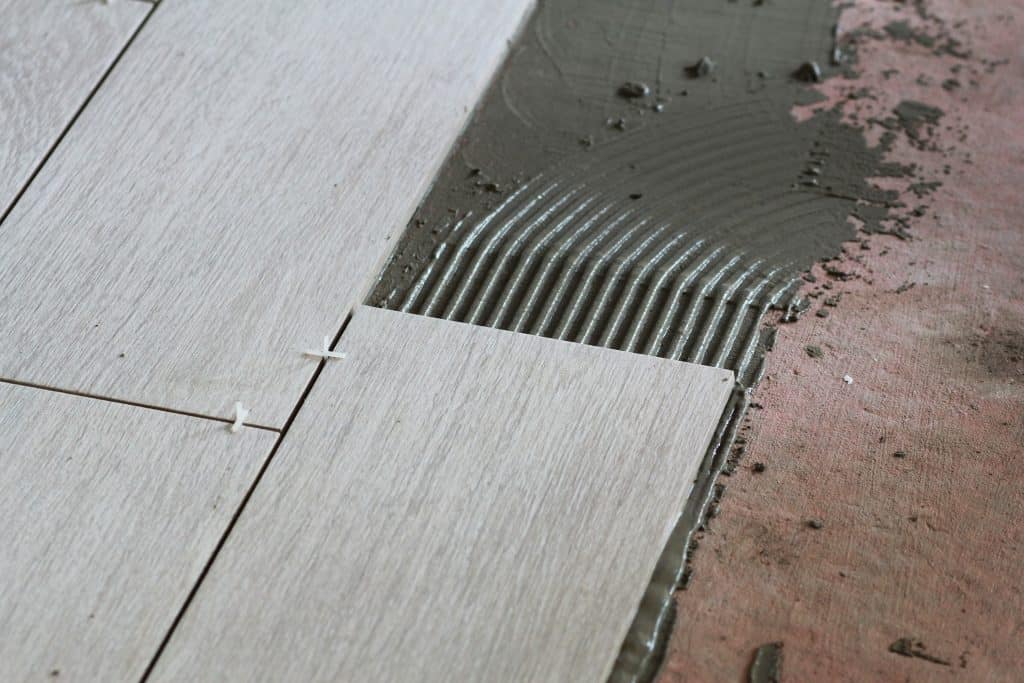As an Amazon Associate we earn from qualifying purchases.
Underneath the tile you have installed on your floor or wall sits either mortar or tile glue. Both are used to firmly attach the tile to the floor. When you are removing tile to replace it, you might run up against a situation where you need to remove tile glue from the tiles you pull up.
I’ve put together a quick guide on how to remove tile glue.
Contents
How to Remove Tile Glue
Before you get started on pulling a tile up, you’ll need to remove the grout surrounding the tile. Depending on the specific grout that was used, you can usually chisel it out fairly simply.
There’s usually a two-step process when removing tile.
- The first step is to remove the tile itself, whether it be cut or chiseled from the surface it is attached to.
- The second step is to remove the adhesive, or tile glue, which held the tile in place.
However, the removal process depends on the type of tile and adhesive used to secure it into place.
There are a number of reasons to remove tile glue from your floor or ceiling. For example, if you want to retile your house, the tile needs to be removed first, and the tile adhesive second. Then you move on to cutting your new tile and installing it in the house.
Tile adhesive isn’t always easy to remove, which is why it’s important to read the guide below. Take into consideration these steps during your next home renovation project.
Removing Tile Mastic
Mastic is a type of organic compound used as an adhesive to secure wall tiles to dry areas. This is commonly used on counters and older flooring. However, since mastic is not water-resistant, it will eventually disintegrate when it comes into contact with water.
When trying to remove tile glue mastic, soak a cloth in water and lay it over the compound. Once it becomes soft, scrape it off the surface with a putty knife.

Removing Thin Set Mortar
This adhesive is a Portland cement product commonly used in wall and floor tiles. Once it’s dried, it’s water-resistant, but brittle in strength. Usually, when you chisel the tiles off, most of the thin set mortar will be removed with it.
Since not all will come off, there will be an uneven layer of adhesive left behind. You will then have to pry off the leftover residue. This can be accomplished using a pry bar to peel off the larger chunks.
I recommend using mortar when you go back to install your new tile shower, bathtub, or fireplace, as it makes a fantastic base.
Removing Vinyl Tile Adhesive
Vinyl tile adhesive is a pliable type of tile adhesive that gets stronger the longer it’s applied. So, the longer amount of time this adhesive has to set, the harder it is to come off.
Usually, you can get a few bits of the adhesive off from scraping the tiles. But, other parts of vinyl tile adhesive may take more time to come off completely.
The first step is to use a putty knife to scrape off the adhesive while applying heat to the adhesive to soften it up. Although you should aim the heat gun toward the adhesive, you shouldn’t press it directly onto it.
Place the gun a couple inches above the surface instead. After heating it for a few minutes, scrape off any adhesive left behind.
Using Solvents to Remove Tile Adhesive
Unfortunately, water and heat often aren’t enough to soften up vinyl tile or mastic adhesive. In these rare cases, a solvent may be needed to break up the adhesive, so you can scrape it off the surface.
- First, identify what kind of adhesive it is so you can buy the correct solvent. Before applying the solvent to the glue, make sure you ventilate the area.
- Apply the product to the glue. Make sure to allow the solvent at least an hour before trying to scrape away the adhesive, or whatever else is left.
Keep in mind, there are warnings for using tile adhesive. If your tile adhesive was installed before 1984, or looks black and tar-like, it might contain asbestos fibers. In the 1960s to 70s, asbestos was regularly used to secure linoleum and vinyl tiles.
If you think your tile adhesive contains asbestos, don’t try to remove it yourself, because it poses a health risk. Instead, contact a professional tile remover/installer to remove the tile adhesive. Or, buy a lead test kit at your local hardware store to determine whether or not your home contains asbestos.
Conclusion
Removing tile glue is no easy task since there are a variety of tile adhesive types and many ways how to remove tile glue. Also, the amount of work it takes to remove tile adhesive depends on how many years it has been in place.
Although you might want to hire a professional to get the job done quicker, it’s not impossible to remove tile glue by yourself. Hopefully, with the help of this guide, you’ll know how to remove a variety of tile glue, vinyl tile adhesive, thin set mortar, and tile mastic.
If you have any problems, you should reach out to professional contractors to remove the tile and the adhesive that may be stuck to the surface of the wall or floor left behind.
